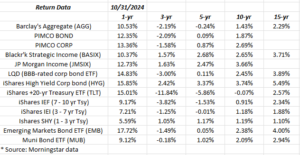Here’s the annual returns for the various bond asset classes as of 10/31/24:
The surprising metric as of 10/31/24, was the TLT or the iShares +20-year Treasury Bond ETF’s 10-year annual return of -0.07%.
That’s a negative 10-year total return.
As of Friday, 11/15/24, that 10-year annual return is even worse at -0.34%.
The best performing asset class in terms of the 1-year return is the Emerging Markets $$ Bond ETF (EMB), which at present has an SEC yield of 5.92%.
US high-yield – as represented above by the HYG or iShares Boxx High Yield Corporate Bond ETF – has a 1-year annual return of 15.85%, which is the second-highest return of the group above.
Like the international equity returns posted as of 10/31/24, shortly after the election, readers wouldn’t know it from the sentiment around both bond and international equity, but the 1-year returns are pretty good for both asset classes.
As of Friday, 11/15/24, the SP 500 (SPY) YTD return is +24.4%, the Barclay’s Aggregate YTD return is +1.45%, and the 60% SPY / 40% AGG balanced account is +15.22%.
Summary / conclusion: It’s clear the 1-year bond market returns, at least the Treasury-related returns are living off the 4th quarter of 2023, since the 1-year return for the Barclay’s Aggregate is just +1.45%, and is thus a considerable drag on the 60% / 40% return of +15.22%.
Reading and listening to the plethora of financial commentators, a Treasury yield curve, which is still inverted since the fed funds rate target is 4.625% as of November 7th’s FOMC announcement, while the 10-year Treasury closed last week, and the week prior at 4.43% and 4.31% respectively. (The 2’s – 10’s Treasury yield spread is now slightly positive and has been since the last week of August is a start, but the widest the spread has been is just +21 bp’s since July ’24.)
See the history in this table. (Click on the spreadsheet to enlarge the data.)
Take it as an opinion, but I do think Jay Powell will cut the fed funds rate again at the December 18th, 2024, FOMC meeting.
That will bring the fed funds rate down to 4.375% and could start to result in a bigger steepening of the Treasury yield curve.
An inverted yield curve inflicts it’s own kind of pain on the financial system, distorting savings and investing.
Schwab’s (SCHW) stock rose 9% this week, and closed at a 2024 high after management came out and said “cash sorting” was starting to improve, as Schwab clients were moving money from the higher-yielding money market accounts to longer maturities, since the fed funds rate is being lowered. Schwab’s higher-yielding money market – the SWVXX yield -peaked in early ’24 near 5.25%, and has already fallen to 4.47% as of Friday, 11/15/24’s close, which is roughly equivalent to the drop in the fed funds rate from 5.375% to 4.625%.
Schwab is and has been a top 10 holding for clients for the last 15 years.
The yield curve shape matters. The inflation hawks will be vocal, but expect the core PCE to continue to come down to the 2% (ish) area.
The question mark – post-election – is how how will trade / tariffs / tax rates change under the President and new Congress, and how much is pro-growth ? The fact is we don’t want the Treasury yield curve to steepen too quickly.
None of this is advice or a recommendation, but only an opinion. Past performance is no guarantee of future results. Investing can and does involve the loss of money, even for short periods of time. None of the above information may be updated and if updated, may not be done in a timely fashion.
Thanks for reading.

